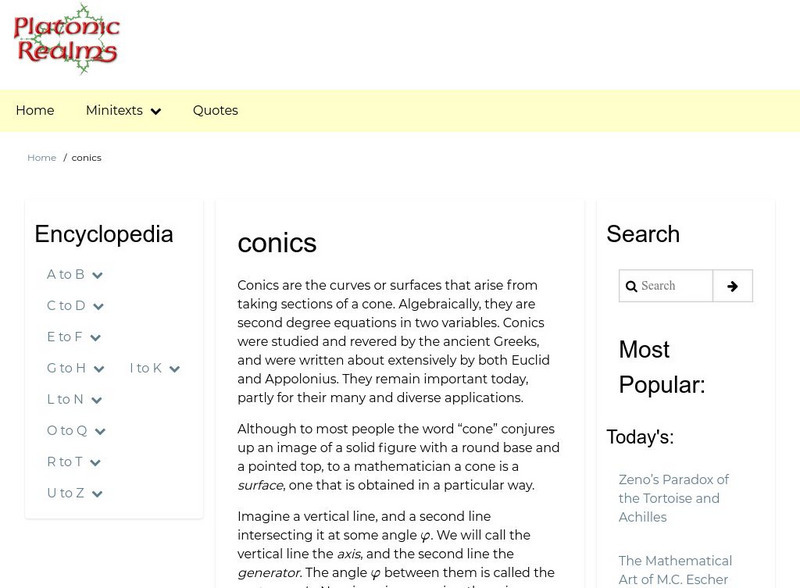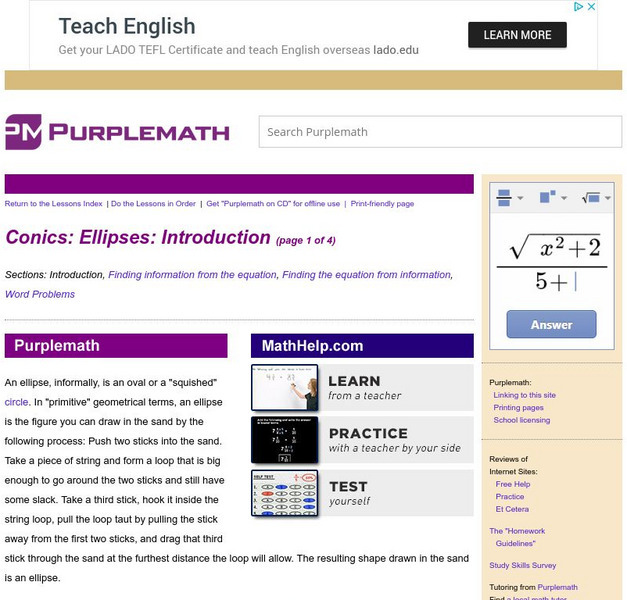Hi, what do you want to do?
University of Washington
Kepler’s Laws
Introduce your physics or astronomy class to Kepler's laws of planetary motion with this straightforward activity. It covers the basic concepts of each and has learners answer questions to demonstrate their grasp on them. You could use...
Curated OER
Hyperbolas: Sketching from the Equation
For this algebra worksheet, students sketch graphs of hyperbolas after solving equations to standard form and interpreting the center, vertices, foci, axis, asymptotes, and eccentricity from the equation. There are 58 questions.
Curated OER
Earth Science Regents: The Ellipse
Starting with the instructions to draw an ellipse, and with great pictures, this sheet should help your pupils learn the shapes and measurements involved. Using push pins and string, your class can discover the axis and focus points...
Curated OER
Orbits Worksheet #2
Brief, but beneficial, this resource draws space scientists into the orbit of a moon around its planet. Assignees answer five multiple choice style questions using a diagram of the planet, the moon's orbit, its focal points, and the...
Curated OER
Orbital Bliss
Most young mathematicians are aware that the planets don’t orbit the sun in a circle but rather as an ellipse, but have never studied this interesting feature. This resource looks at the planetary orbits in more detail and helps learners...
Curated OER
Eccentricity of Conic Sections
In this conic sections worksheet, 11th graders solve and complete 26 various types of problems. First, they identify the eccentricity of each equation shown. Then, students use the information provided to write the standard form equation...
Curated OER
Ellipses
In this ellipses worksheet, learners calculate the eccentricity of 5 given ellipses and show their calculations. Students then determine the percent deviation for their calculations using the accepted values of eccentricity.
Curated OER
Drawing Ellipses Lab
In this ellipse worksheet, students learn the difference between an orbit and an ellipse. They draw ellipses and calculate the distance between foci, they calculate the length of the major axis and they determine the eccentricity. They...
Curated OER
Eccentricity
In this eccentricity worksheet, students solve and complete 20 various types of problems that include the eccentricity of an ellipse and a hyperbola. First, they graph each ellipse and list the variable values, calculating the...
Curated OER
Toilet Paper Solar System
Students create a model of the distances of the planets in the solar system using sheets of toilet paper and markers. Generally accepted orbital parameters are applied.
Curated OER
Ellipses
In this ellipses worksheet, students measure and calculate the eccentricity of each ellipse and then calculate the percent deviation. This worksheet has 10 problems to solve.
Other
Platonic Realms: Function
Resource provides an introduction to conics. A picture of each conic, the definition, and a brief discussion about the standard form of conic equations are given, along with encouragement to master conics.
Other
Platonic Realms: Conics
This resource provides in depth information on the conic sections. Click on the underlined words for definitions and diagrams.
Varsity Tutors
Varsity Tutors: Hotmath: Practice Problems: Conic Sections
Hotmath provides 26 practice problems relating to conic sections. Each of the practice problems include a step-by-step guide for solving their conic.
Purple Math
Purplemath: Conics: Hyperbolas
A three-part tutorial that discusses the basic terms, definitions, and formulas related to hyperbolas.
NASA
Nasa: Kepler and His Laws
This site from NASA provides biographical details about the lives of Tycho Brahe and Johannes Kepler. Discusses Kepler's successes at developing laws of planeatry motion. States the three laws and discusses each one individually....
Math Is Fun
Math Is Fun: Conic Sections
Students learn about conic sections. Topics include eccentricity, directrix, and the general equation. The tutorial consists of notes, examples, and practice problems to check for comprehension.
Georgia State University
Georgia State University: Hyper Physics: Kepler's Laws
An outstanding page describing Kepler's three laws of planetary motion.
Purple Math
Purplemath: Conics: Ellipses: Introduction
Introduces the basic terms, variables, and equations for ellipses, and discusses their physical properties.
NASA
Nasa: Kepler's Second Law
This site from NASA states Kepler's second law of planetary motion and depicts its meaning with an informative diagram. Relates the law to conservation of energy principles and discusses the eccentricity of a satellite's (or a planet's)...
Wolfram Research
Wolfram Math World: Eccentricity
This site explains eccentricity, the quantity defined by a conic section to determine its type of conic section. Has links to related topics.
Cornell University
Cornell University: Astronomy: Orbital Motion and Kepler's Laws
At this site from the Astronomy Department of Cornell University, Kepler's three laws of planetary motion are stated. There are brief explanations of each, along with links to additional information on related subjects.
Other
Sandburg Center for Sky Awareness: What Are the Shapes of the Planets' Orbits?
In this lesson plan investigation learners learn about the shapes of the planetary orbits by experimenting with ellipses of different proportions.



























